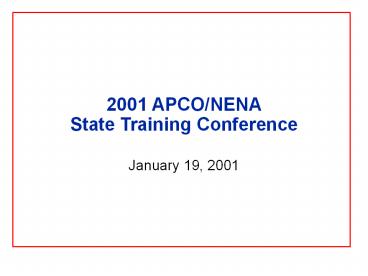2001 APCO/NENA State Training Conference - PowerPoint PPT Presentation
Title:
2001 APCO/NENA State Training Conference
Description:
Title: PowerPoint Presentation Author: Andrew Corporation Last modified by: hvalenzu Created Date: 10/6/2000 8:01:39 PM Document presentation format – PowerPoint PPT presentation
Number of Views:127
Avg rating:3.0/5.0
Title: 2001 APCO/NENA State Training Conference
1
2001 APCO/NENA State Training Conference
- January 19, 2001
2
An Antenna is An effective interface between
the radio and free space
Free space
Antenna
For Terrestrial Communications, antennas must be
directional
Radio
3
Terrestrial Microwave Antennas for Point-To-Point
Communication
- Terrestrial microwave antennas generate a beam of
RF signal to communicate between two locations. - Point-To-Point communication depends upon a clear
line of sight between two microwave antennas. - Obstructions, such as buildings, trees or terrain
interfere with the signal. - Depending upon the location, usage and frequency,
different types can be utilized. - We will address the basic characteristics of
these various types
4
Electrical Performance Parameters
5
Parabolic AntennaDirective Gain
Ga (dBi) 10 log10 h 4 p Aa / l2
Where Ga Antenna Directive Gain (Catalog
spec) h Aperture Efficiency (50-55) Aa
Antenna Aperture Area l Wavelength
(speed of light / frequency)
6
Typical ParabolicAntenna Gain in dBi
Antenna Diameter
Frequency
7
Radiation Pattern Concept
Antenna Under Test
Antenna Test Range
Source Antenna
8
Radiation Patternabout Bore sight
9
Cut Through Radiation Pattern at Boresight
10
Front to Back Ratio
- Ratio of the signal level at beam peak to that
directed behind the antenna - Considered in intra-system interference
calculation (hop overreach) - Expressed in dB
11
Co-Polarization and Cross-Polarization
- Co-Polarization
- Where Transmit Receive Antennas have the Same
Polarization - Either Horizontal or Vertical (HH or VV)
- In your System, The Wanted Signal
Co-polarized antenna pattern
XPD
Relative Power
- Cross-Polarization
- Where Transmit Receive Antennas have Different
Polarizations - Either HV or VH.
- In your System, The Unwanted Signal
X-polarized patttern
Azimuth Angle
12
Inter-port Isolation (IPI)
Feed Horn
- Leakage of Signal Between Antenna Ports
- Internal Noise
- Expressed in dB
Towards Reflector
Transmit Signal
Leakage Signal
13
Voltage Standing Wave Ratio (VSWR)
Incident Signal
Reflected Signal
VSWR 1 (Reflection Coefficient) 1 -
(Reflection Coefficient)
- VSWR 1.30 Reflection Coefficient 13 (0.13)
- VSWR 1.20 Reflection Coefficient 9.1
(0.091) - VSWR 1.10 Reflection Coefficient 4.7
(0.047) - VSWR 1.08 Reflection Coefficient 3.8
(0.038) - VSWR 1.06 Reflection Coefficient 2.9 (0.029)
14
Return Loss The Amount of Energy Lost due to
Reflected (Returned) Signal
RL -20 x log (Reflection Coefficient)
- RL 17.8dB Reflection 13 (0.13) VSWR 1.30
- RL 20.8dB Reflection 9.1 (0.091) VSWR
1.20 - RL 26.7dB Reflection 4.7 (0.047) VSWR
1.10 - RL 28.4dB Reflection 3.8 (0.038) VSWR
1.08 - RL 30.7dB Reflection 2.9 (0.029) VSWR
1.06
15
Basic Antenna Types
Standard Parabolic Antenna
Focal Plane Antenna
Shielded Antenna
GRIDPAK Antenna
16
GRIDPAK Antenna
- Grid Reflector
- Low Wind load
- Single Polarized
- Below 2.7GHz
- Shipped in Flat, Lightweight Package
17
Standard Parabolic Antenna
- Basic Antenna
- Comprised of
- Reflector
- Feed Assembly
- Mount
18
Focal Plane Antenna
- Deeper Reflector
- Edge Geometry
- Improved F/B Ratio
- Slightly Lower Gain
19
Shielded Antenna
- Absorber-Lined Shield
- Improved Feed System
- Planar Radome
- Improved RPE
20
Antenna Efficiency
- Well-designed antennas have efficiency ratings of
45 - 65
- Efficiency Factor Affected By
- Feed Illumination
- Aperture Blockage
- Reflector Surface Tolerance
- Efficiency can never be 100
21
Antenna f/D Ratio
f
f
D
D
f/D 0.333
f/D 0.250
Standard Shielded Antennas
Focal Plane Antennas
22
Unwanted Signals
Scattering
Spillover
Diffraction
23
Front to Back Ratio
Direction of Signal
Direction of Signal
Direction of Signal
Shielded Antenna
Focal Plane Antenna
Standard Parabolic Antenna
24
Parabolic Reflector Beamwidth
Diameter
Frequency
Beamwidth in Degrees
25
Radiation Pattern Envelope
0
10
20
30
40
50
Antenna Directivity dB down from Main Lobe
60
70
80
90
100
0
10
15
20
5
40
60
80
100
120
140
160
180
Azimuth - Degrees from Main Lobe
26
Radomes
- Reduce Windloading on Tower
- Protection Against Ice, Snow and Dirt
27
Other Antenna Options
- High XPD antennas
- Dual beam antennas
- Dual band antennas
- Low profile antennas
- Integrated antennas































